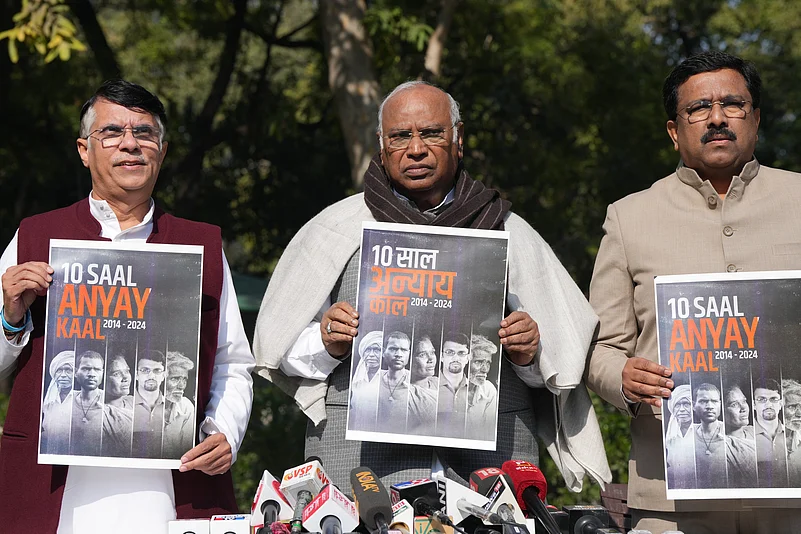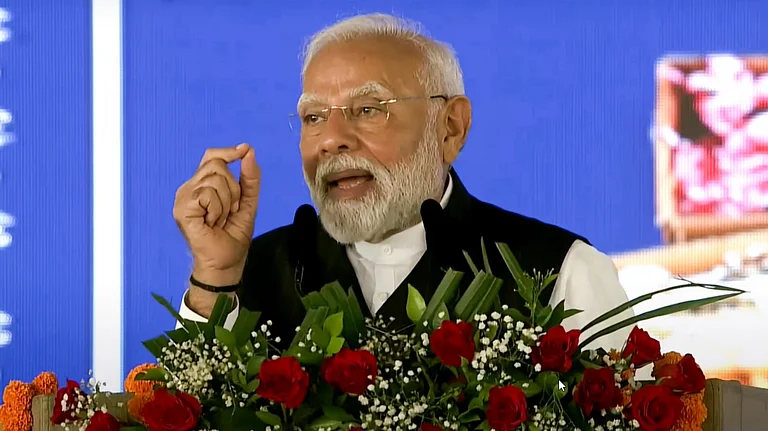The Narendra Modi government on Thursday tabled a white paper on the Indian economy in the parliament that essentially compared the 10 years of the Congress-led United Progressive Alliance (UPA) government and the Bharatiya Janata Party (BJP)-led National Democratic Alliance (NDA) government since 2014.
The crux of the white paper was that the Manmohan Singh-led UPA government inherited a robust economy pumped by the reform-driven previous government of BJP's Atal Bihar Vajpayee (1998-2004), but ruined it by 2014, and, after the Modi government came to power in 2014, it turned around the Indian economy again.
Hours before Union Finance Minister Nirmala Sitharaman tabled the white paper in the parliament, Congress published its own 'black paper' that indicted the Modi government's economic policies. The party dubbed its paper '10 Saal Anyay Kaal 2014-2024 (10 Years of Injustice (2014-2024)'.
While white papers are conventionally policy documents, this white paper of Modi government and the Congress party's retaliatory black paper are overtly political. Coming weeks ahead of the 2024 general elections, the white paper is yet another push to discredit the Opposition and hammer its previous governance record in the eyes of the voters. While the white paper flagged the UPA-era banking crisis, corruption, and inflation, the black paper of the Congress party in response, slammed the Modi government for unemployment and "the economic, social, and political injustice".
Here we explain what the Centre's white paper said, the politics around it, and what Congress' black paper says.
What Does Modi Govt's White Paper Say?
The main focus of the white paper is comparing the economic performance of the Congress-led UPA (2004-14) and BJP-led NDA (2014-) governments. The main argument being that the UPA inherited a good economy and rode on the back of the previous Atal Bihari Vajpayee-led government of BJP but tanked the economy nonetheless and it was the Modi government post-2014 that revived it.
Despite the Vajpayee-led NDA government having handed over a healthy and resilient economy with high growth potential to the Congress-led UPA government in 2014, the new government's 10 years were The UPA era was plagued by double-digit inflation, ailing banking sector following excessive lending during the boom phase, and high policy uncertainty, which "marred India's business climate, dented its image and the people's confidence about their future", says the white paper.
"There were numerous scams bringing colossal revenue losses for the exchequer and fiscal and revenue deficits spiralling out of control," the paper mentions.
It also states the Indian economy was in the 'fragile five' by 2014 and now it's among the top five under the Modi government and also that the UPA government abandoned the 1991 liberalisation economic reforms after coming to the power in 2004.
Listing the series of 'scams', the paper also says that there was "pervasive corruption" during the UPA era, listing the following cases: Coal block allocation, Commonwealth Games, 2G telecom scam, Saradha chit fund, INX Media case, Aircel-Maxis case, Antrix-Devas deal, land for jobs, allotment of land in Panchkula and Gurgaon, Augusta Westland case.
The paper says the responsibility to clean up the mess fell before the Modi government. The Hindustan Times listed the paper as listing the following steps taken up by the current government:
• Expenditure reform commission formed to rationalise, prioritise public expenditures
• Pace of highway construction rose from 12 km a day in 2015 to 28 km a day in 2023
• Measures taken to unearth black money
• Reforms removed the sting of high cost of living for households
• Digital revolution, elimination of open defecation, vaccinating against Covid-19, diversifying exports
• Procurement of critical defence equipment
• PM-Kisan Samman Nidhi empowered farmers, improved their income
How Did Congress Counter Govt's White Paper?
Hours ahead of the tabling of the Modi government's white paper, Congress released a 'black paper' in which it sought to indict the Modi government's for its socioeconomic policies. It dubbed the document as '10 Saal Anyay Kaal 2014-2024 (10 Years of Injustice (2014-2024)'.
The Congress' paper says the Modi government "devastated" the Indian economy and that unemployment has been "aggravated" and agriculture sector has been "destroyed" since 2014 and that it has "abetted" crimes against women and "committed grave injustices" against minorities, according to The Indian Express.
It further showcases "the economic, social and political injustice" under the Modi government over the past ten years and also the spread of social disharmony and the compromise of national security," as mentioned on The Express.
Releasing the booklet, Congress President Mallikarjuna Kharge criticised Prime Minister Narendra Modi on several issues, including his assertion that it was the NDA government that had made persons from SC/ST communities President.
"That is not important. Yeh toh bante rahte hain (they keep becoming)… We also made a person from the SC community the President (K R Narayanan)," said Kharge, as quoted by The Express.
Further comparing Naryanan and current President Droupadi Murmu, Kharge said: "I am not criticising her (President Droupadi Murmu)… I value her worth. Lekin achche, padhe likhe logon ko, achche internationally famous (But good, well-educated and internationally famous people)… (Naryanan) was a journalist, an ambassador… then became Vice-President and President."
What's Politics Around White And Black Papers?
Weeks ahead of the 2024 general elections, the Centre's white paper has been seen as a tool to bolster its case politically. This is the case as observers have said that the white paper is political in its tone and has also cherry-picked data and facts at several points. For one, while the white paper rightly says the inflation reached double digits in UPA era, it does not mention that India achieved the fastest-ever economic growth in 2004-08.
Rajeev Jayaswal in Hindustan Times dubbed the paper "in equal parts a report card of a decade in power for the Bharatiya Janata Party-led National Democratic Alliance, and a campaign cry ahead of the summer's general elections".
Citing two former Finance Secretaries, The Express in an article noted that the framing of the paper where it starts with "when we formed the government" is an unusual departure from tradition. The newspaper further noted that this framing set the tone for the paper which then went on to flag the worst of the UPA era.
Writing separately in The Express, Udit Misra, however, noted that while the paper is prima facie factually correct, it "cherry-picks data to tell the truth about UPA's failures and NDA government's successes without touching upon UPA's successes and or its own failures".
Misra noted the following positive highlights of the UPA era that the white paper missed:
India experienced fastest period of growth rate during 2004-09
India grew the fastest-ever during 2004-08 at "fairly moderate rate of inflation"
In the same period, India also saw the best fiscal performance
India overcame the 2008 global financial crisis largely unscathed
On the other hand, Misra notes that the Modi government too has positives like the goods and services act, the insolvency code, the increased capital expenditure, and cleaning up the banks' balance sheets, but there is also the issue of long-term moderate inflation and employment stress that the paper skips entirely.


























